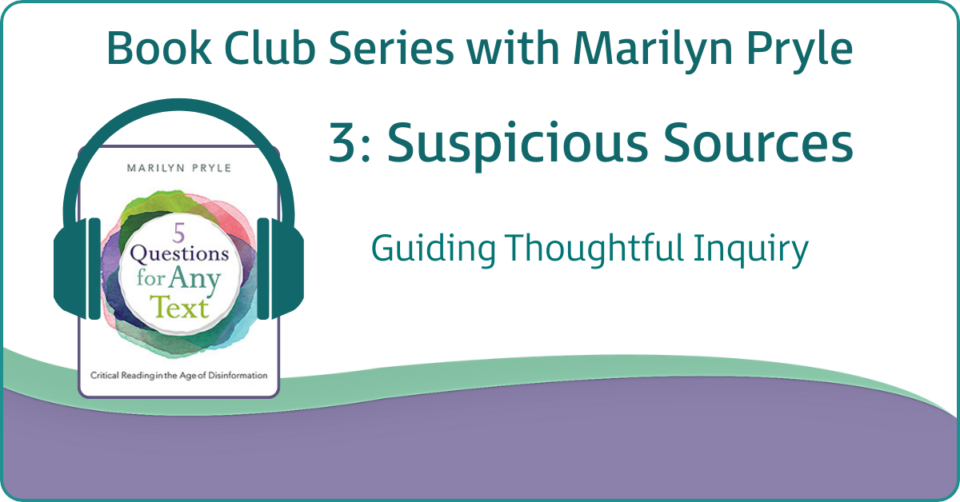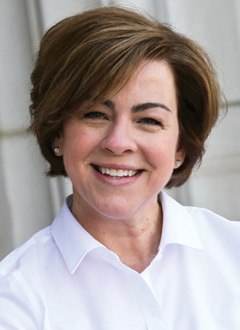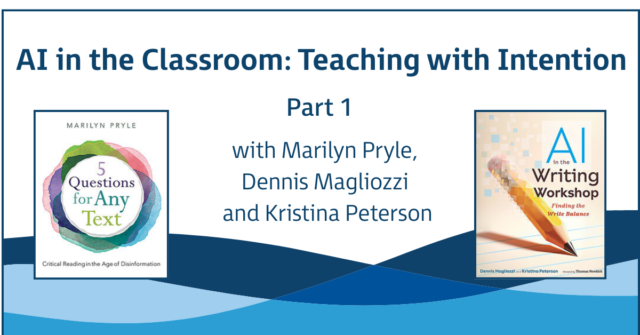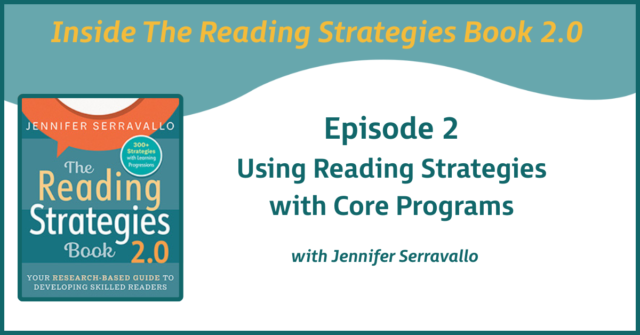
Can your students spot misinformation before it spreads?
In 5 Questions for Any Text, educator and author Marilyn Pryle shares a practical framework to help students read more critically in today's media-saturated world.
In episode three of this four-part series, we explore the concept of suspicious sources through real student responses, from a 10th-grader's critique of a news segment to an eighth-grader's analysis of a conspiracy theory video. You'll hear how Marilyn guides students from emotional reactions to thoughtful inquiry. Helping them ask, "What makes a source trustworthy?"
The episode includes an excerpt from the audiobook, followed by a reflection and a few prompting questions from Marilyn.
Transcript
Marilyn Pryle (audiobook excerpt):
Readers might think about this category by asking themselves, "Are the sources quoted in the text reliable or unreliable? How do I know? Do the sources themselves reveal a bias? Or are any of the facts skewed or taken out of context?"
Teachers been been prodding students to check their sources for decades. Now, this imperative is more important than ever. By middle school, this concept should not be new, and by high school, it should be ingrained. Of course, as the years go on, checking sources becomes more difficult. Websites that look reliable might be fabricated. Experts may simply be uninformed commenters. Institutions might be funded by dubious or biased sources. Rooting these facts out can be daunting for a student.
Sometimes, as the prompt suggests, the facts might be accurate, but the way they are presented is intentionally distorted. Realizing this requires a sophisticated level of critical thinking. Start with asking students what makes a source reliable. Students can work in pairs or small groups to come up with criteria and the class can discuss. Several resources exist online as well.
Media literacy educator Frank Baker talks about the importance of teaching students to read laterally by checking facts as they read, rather than after they read. In his 2019 MiddleWeb article Real Media Literacy: Spotting a Fake Story, Frank Baker includes a fake news story that can be checked as a classroom activity and gives steps to take to check it. Civics' CTRL-F online resources provides several examples of articles to be fact-checked and suggests various ways students can investigate each. News Literacy Project's online resource library gives grade-level specific lesson plans to help students identify misinformation. Scroll through tor find something interesting and appropriate for your students.
Mentally questioning sources, and if needed following up with further research, must become a habit for students not only in school, but at all times. Students are bombarded with information on all websites and social media platforms. They must habitually ask themselves if claims are accurate and presented objectively. Eventually, this should become more than a habit. It should be an unconscious reflex. Notice that several other categories overlap with this one, each with its own slightly different shade of meaning. We must provide students with as many doors as possible into this inquiry. This will nurture flexible, wide-ranging critical thinking.
Let's listen to a few student-reading responses for these suspicious sources category. Here's 10-grader John's response to why we're paranoid about the American food supply. "I was scrolling through the news channels and came across this news story about the question of why chickens are not laying eggs and egg prices being driven up. Notably, the host of the show provided absolutely no sources or support for his claim that chemicals were being put secretly into chicken feed so they would not lay eggs. He had no source for this theory other than talking to a TikTok star who raises chickens. The host further implied that there is some conspiracy by the administration or willful ignorance by the administration about this problem. Nothing in this news piece was supported by any reliable source."
I noticed that John did not include a quote. Often, I have to remind students to re-watch a video in order to grab a quote. I asked John, "What would be a more reliable source for this topic? What is a source people can trust? What is the danger of social media experts?" I also asked John why news reporters have a special responsibility to find reliable sources. What damage can be done if news outlets are irresponsible?
Here's a response from Matilda, an eighth-grader, to the video Humans Lived on Mars. "Before watching this video, one might notice that it is tagged with #conspiracy and #theory. It's a conspiracy theory. There are also a lot of holes in this argument. If humans had an entire civilization on Mars, fun idea to play with and interesting book idea, but not real, what about human evolution? What about our current day societies? This also assumes that humans lived on Mars and had a society there, but then had a nuclear war which turned the whole place into a dried-up planet and that's why we can't breathe there now. But the pictures in the video show a society on Mars' red and inhospitable surface, so how would people breathe?"
"The only thing in the video that you can't immediately hear and realize that it's not possible is what they say about xenon. They say that there is xenon on Mars and that 'xenon on Earth is only found after a nuclear explosion.' I don't know anything about xenon except that it's a noble gas, so I can't say if this is wrong so I googled xenon. According to Britannica, xenon is present in asteroids. Guess what? Humans don't put atomic bombs on asteroids, so xenon can't come only from human-made atomic bombs."
I wondered if Matilda thought the video being labeled #conspiracy and #theory would stop viewers from believing it. Why do people believe things that they know might not be true? I asked Matilda what, if anything, was cited or sourced in any way. Did the creators allude to any organization, report, or text at all? What kinds of sources might have given some credibility to these claims?
Conferring with students. When we're conferring with students, we always begin by responding to them personally. Although both John much Matilda were obviously fired up about the lack of reliable sourcing in their videos, neither seemed personally in need of support over the issue. Once we've responded to the student, we can work on developing critical consciousness. Both John's and Matilda's reactions were normal reactions to the idea of being duped. John's tone was mocking, bordering on cynical, and Matilda's was annoyed, bordering on anger. It is not uncommon for students to rant in an RR.
Both reactions are very human ones. However, a crucial aspect of our work as teachers is to help students have rational discussions rooted in facts and logic. While recognizing their reactions and affirming their accusations of suspicious sources, I also tried to keep each student grounded in civil discourse and did not participate in bashing either the news outlet or the TikTok creators. By asking what sources would have been reliable, I kept the students focused on facts versus fiction, not the character of the creators. This would also help them to be on the lookout for reliable sources before they chose to read a text. Finally, here's one last question for taking the conversation further. How do I know this text is being truthful?
Marilyn (commentary):
A category like this is so difficult to teach in school because we vet all of our sources as teachers. We're not going to give our students bad sources. I find that when teachers do teach this category or this concept, can we trust a source, is it a suspicious source, we purposefully give them something that's bad and then we frame it as, "Okay, what do you notice about these sources? How are they bad?" That helps to a point, but it doesn't necessarily help the student out in the world where we are all bombarded with fake news, and things that are not true. How do we create space for students to have a hunch about something? I find that this category is about having hunches and following the hunch. How do we make space for that in our classrooms?
I want to tell a story of something that happened to me, a real life story about this hunch feeling. I was the Pennsylvania Teacher of the Year in 2019 and 2020. Part of that experience was that I went with my cohort of other state teachers of the year for that year to Space Camp in Huntsville, Alabama. It is awesome. Space Camp is so cool. But when we were there that very first night, we got a tour of the museum. Our docent was an older gentleman who had worked as a NASA scientist, so it was really special. He was explaining all the artifacts to us. As we were walking around the old space suits and the parts of spaceships and all of that kind of stuff, he's explaining how is mentors were all German and he was very proud of this. He was rattling off all the names, all German names. This was his NASA pedigree and he was extremely proud of this.
I had this hunch. I thought, "Why are they all German? Where is this coming from? I think I've learned about this," because we don't teach about this in schools. I asked him, "When did all of your mentors come over? They're all from Germany." He said, "I know what you're thinking. It wasn't like that. We had to do it." He starts talking very ambiguously. Again, this is, when I think about question three as a whole, what is it hiding, what is the text hiding, this is it. This was a real life moment, so much being unsaid. The teacher, another teacher of the year next to me turned to me and she said, "What are you guys talking about?" I said, "They were all Nazis, these Germans that came over." Again, we don't teach this, so a lot of the other teachers didn't even know about this.
That moment where you have a hunch where you're not being told the whole story. Let me be clear, I love NASA. I don't want to undo any of the progress that we've made, but I think there should be space for complexity. This is what we have to make space for in our classrooms. How do we help students tolerate complexity? What would have helped in that situation is just a single poster that said, "We have a complex history. These are where the original scientists were from, but here is the situation." The main audience for Space Camp is fourth and fifth-graders, so we're not giving them the whole story. These kids are going to grow up and ask these questions later, and it'll all be very confusing.
Let me contrast that with an experience I had a year after that, where I was at one of my favorite places in the world, the Boston Museum of Fine Arts. In front of the museum, there's a beautiful statue and it's of an Indigenous person on a horse playing. I believe it's called Prayer to the Great Spirit, or something like that. He has his arms open and he's looking up to the sky. The statue's beautiful. It's emblematic of the Boston MFA. But when I was there at this particular moment, I thought to myself, I had that hunch again, "Where's this coming from? Who was the creator of this?" I walked around to the front of the statue and sure enough, there was a plaque there and it talked about who the sculptor was. He was not Indigenous. Some of the details of the sculpture did not even add up. Even though the final product was very beautiful, it wasn't necessarily 100% accurate.
Then the plaque said, "Even though this statue is beloved by generations, it is the subject of debate and it brings up our complex history. We continue to wrestle with that." This is what was on the plaque. That is what I think we need to make space for our in classrooms. How can students have a hunch and inquire about it? And accept the complexity. A global skill, it's already important and it's going to continue to become more important, is a tolerance for ambiguity. How can we make space for this in our classrooms, where students can just sit with this complexity and ambiguity?
When I look at a category like suspicious sources, and I know the examples in this chapter are about actual untruths, I see it even as a larger thing where how do we help students pinpoint fake news, and call it fake, and not be taken in by the conspiracy theories, yes. But also, how do we make space for them to have a hunch, inquire about the hunch, tolerate the complexity in a situation? That's where I see the gift of this category.
If you're discussing this in a book club, I would say talk about, in your own real lives, have you experienced moments where you had a hunch about something and somehow you've followed up, or maybe you didn't follow up, but that question was lingering in your mind? Then another question to talk about could be in your own classroom, how can you build in more space for students to just interact with this idea of complexity that is our world?
ABOUT THE AUTHOR

Marilyn Pryle is a National Board Certified Teacher with over 25 years of experience in education. She teaches 10th grade English in Clarks Summit, PA, and is the author of several books for teachers, including 5 Questions for Any Text, Reading with Presence, and 50 Writing Activities for Meeting Higher Standards. Marilyn holds an Ed.D. in Curriculum & Instruction and was the 2020 Pennsylvania Teacher of the Year.


